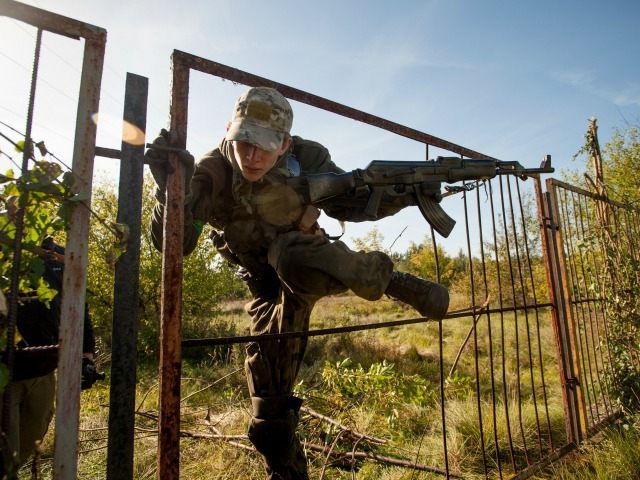Poland, ripped apart by Germany and Soviet Union in World War II, wants to implement a “46,000-strong” National Guard, partly in response to Russian military action.
“We already have the ‘green light’ and have started on the preliminary measures for forming a territorial defence force that will be an integral part of the army,” declared Defense Minister Antoni Macierewicz.
The Telegraph reports the Polish national guard will mirror the U.S. National Guard, acting as “a new branch of the Polish army and separate from Poland’s established national reserve force.”
In February, the government announced a plan to invest in over $42 billion on military equipment and training to strengthen their forces.
They no longer believe “peace in Europe is a given.” The $42 billion upgrade is the first in a decade, which includes “a missile shield and anti-aircraft systems as well as combat drones.” If the government purchases cruise missiles, then the air force can “attack targets in Russia without having to leave their own air force base.” Warsaw admits the crisis in Ukraine is the reason why the country needs to boost their defenses.
“The key to a political and military solution lies in Moscow,” announced President Bronislaw Komorowski. “The possibility of a lasting peace still isn’t close.”
Russia invaded Ukraine after the pro-West government ousted Russian-backed President Viktor Yanukovych on February 22, 2014. Russian President Vladimir Putin then annexed Crimea while Russian diplomats made veiled threats against Estonia and Latvia, which caused officials there to fear they were next.
NATO hopes to strengthen their presence in eastern Europe due to the aggression. The defense ministers want to “set up six command and control centers in Bulgaria, Poland, Romania, and the three Baltic countries of Estonia, Latvia, and Lithuania.”
Poland faced some of the worst war crimes in World War II due to the Molotov-Ribbentrop Pact between Germany and USSR, signed on August 23, 1939. Germany promised not to declare war on Russia while both countries agreed on dividing Estonia, Finland, Latvia, Lithuania, Poland, and Romania. Poland, however, was the country Josef Stalin and Adolf Hitler both desired. The pact divided Poland between Germany and USSR “approximately by the line of the rivers Narev, Vistula and San.”
Putin caused waves in November 2014 when he praised the pact.
“Serious research must show that those were the foreign policy methods then,” Putin told a group of young historians in Moscow. “The Soviet Union signed a non-aggression treaty with Germany. People say, ‘Ach, that’s bad.’ But what’s bad about that if the Soviet Union didn’t want to fight, what’s bad about it?”
Putin’s remark disregards Soviet aggression that belies the claim that the USSR “didn’t want to fight.” The nation did fight–just not with Germany. One week later, on September 1, 1939, Hitler invaded Poland and started WWII. The Soviet Union invaded Poland on September 17, 1939, which violated the Soviet-Polish Non-Aggression Pact. With both countries in Poland, the USSR and Germany signed an agreement to coordinate the militaries in the country.
The invasion was the scene of the Katyn massacre by the Soviet secret police in April and May 1940, considered among the worst war crimes of that period. Polish army members and citizens were sent to labor camps. The Soviet police interviewed the army and police officers to decide who should live or die. In March, Stalin and members of the Communist Party decided to execute almost 30,000 Polish citizens as a way to quash any attempts at a future Polish army.
The Germans murdered almost six million Poles, nearly half of them Jewish. Overall, between the German and USSR occupation, Poland lost over 21% of its population. Over 90% of casualties were civilians.
Unfortunately, Poland’s situation did not prosper at the end of World War II. At the Yalta Conference, American President Franklin Roosevelt and British Prime Minister Winston Churchill allowed Stalin to keep territory he seized under his pact with Hitler.
Poland felt betrayed by the Allies, especially after the USSR established a puppet Communist government in the country. The first election in Poland voted to allow the Soviet Union to be in control of Polish affairs. This government agreed to the Soviet annexation of the eastern territory and allowed the Red Army on Polish lands. Therefore, Poland was not officially a member of the USSR, but a satellite state.
Poland’s government currently appears poised to prevent a similar situation with the upgrades in defense and National Guard plans. Poland belongs to the European Union and NATO, but neither organization has taken much action against Russia.
The West has come under criticism for not doing enough to stop Russian President Vladimir Putin. While the U.S. and European Union have imposed at least four rounds of sanctions against Russia, many in Eastern Europe see the response as damningly noncommital. The Kyiv Post wrote a scathing editorial that said, “[N]ow we know why two world wars started in Europe and the dangers of appeasement.” The article continued to lash out at the EU’s “weak resolve” as east Ukraine faces violence every day.

COMMENTS
Please let us know if you're having issues with commenting.